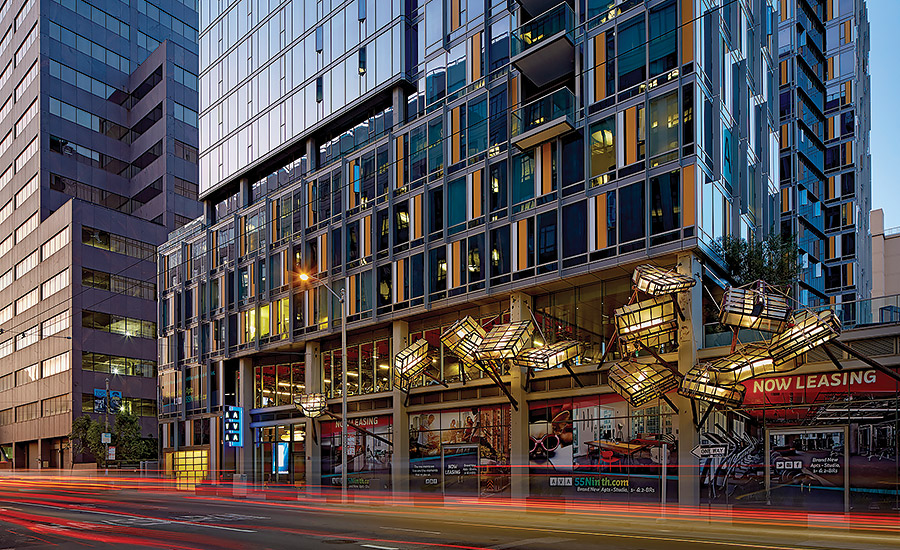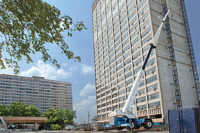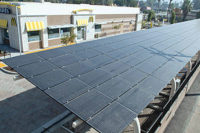Tankless water heating technology has demonstrated its workability in a wide range of building projects. But what about a large, high-rise, multifamily project with 273 apartments on 16 levels?
Opened in October 2014, the new AVA 55 Ninth high-rise apartment building in San Francisco has answered this question in the affirmative. The property combines tankless water heating with sustainable features that helped to earn LEED Gold certification.
The domestic hot water (DHW) system on the property combines 18 separate, gas-fired tankless water heaters into a single cohesive operation. Made by Noritz America, the NCC1991-DV units are hung and piped together in a 16-ft by 7-ft, custom-fabricated, Unistrut rack system located in a 1,000-sq-ft “penthouse” mechanical room on the roof. Direct-vented with 4-in PVC piping through a nearby wall to the exterior, each water heater ramps its outputs up and down with the building’s changing demand for hot water throughout the day.
The heater package was designed and installed by ACCO Engineered Systems of San Leandro, CA. Lead plumbing engineer Kevin Hunt did the design in 2012.
“Tankless technology was a good fit for this building, and it helped us achieve our goal of LEED Gold certification,” said Tony Joyce, project engineer for several AvalonBay properties, including AVA 55 Ninth.
The impetus for the design was the anticipated energy savings and how it would help with achieving LEED Gold. But other considerations played key roles.
For example, a solar hydrothermal pre-heating system was installed to meet California’s building energy efficiency standards. By trimming the energy draw of the tankless water heaters, “the solar pre-heating system reduces the building’s overall energy consumption,” explains Joyce.
Developers also looked at redundancy. An apartment complex the size of AVA 55 Ninth typically uses hot water much like a large hotel: peak demand, or close to it, first thing in the morning; low-level usage throughout the day while most tenants are away; a second, smaller spike in the evening when tenants return.
That ever-fluctuating demand is why 18 heaters were used. Such a large number of units permit a more precise response to the hot-water usage habits of 273 different tenants. When all 18 are fully operational, total consumption is 199,900 Btuh x 18, or 3,598,200 Btuh. Total flow rate: 104.6 gallons per minute.
Of course, actual demand is usually well short of that maximum, and sometimes there is comparatively little demand at all. But when a tenant does turn on a tap, they expect the hot water to flow all but instantaneously. The AVA 55 Ninth system responds to that need by having at least one tankless unit operating at all times, keeping water at a minimum temperature constantly circulating to all 273 units. As demand grows, the other 17 heaters fire in whatever sequence is required to meet it.
A single control unit connected to all 18 heaters orchestrates this sequencing process, making sure demand is fully met with minimum energy expenditure.
“It’s not quite plug-and-play,” says Hunt, but the system controller (which can handle 24 units total) “made it easier to organize the hot and cold water lines as well as the gas and condensate connections in the rack, and then to set the system.”
Each NCC1991 has a minimum consumption of 16,000 Btuh. That calculates into a turndown ratio of 225 to 1 (3,598,200 divided by 16,000). The higher the ratio, the greater the capability of a system to adjust to the wide-ranging demand of a large, multi-family community.
“The high turndown ratio allows the system to maintain a steady water temperature even with a single unit running at only its minimum,” says Hunt. “This approach is much more efficient than a system that’s constantly cycling on and off. That kind of ‘short-cycling’ would result in significant — and noticeable — temperature fluctuations in water temperatures for the tenants.”
Meanwhile, the solar thermal setup allows this always-on system to still function efficiently by minimizing the energy needed to raise the temperature of water coming into the heaters. And absent any storage tank, there is no wasted energy beyond the heat lost through the building’s supply piping, as the water circulates through it.
Whatever concerns AvalonBay and ACCO had initially regarding the ability of a tankless system to meet the considerable hot water needs, the system sizing and design phase answered them to everyone’s satisfaction.
“Sizing the system correctly was a major emphasis,” says Hunt, “so we took extra care — speaking with the local rep, working with the design team at Noritz, and using their online sizing calculator on top of our own calculations, based on ASPE recommendations.”
One significant area of focus was the diameter of the supply lines needed to bring gas to the water heaters. Early on, ACCO arranged for medium-pressure service, or 2 psi.
“As a result, we cut the diameter of the gas piping from 6 in to 2.5,” says Hunt, “which was a substantial cost savings."




